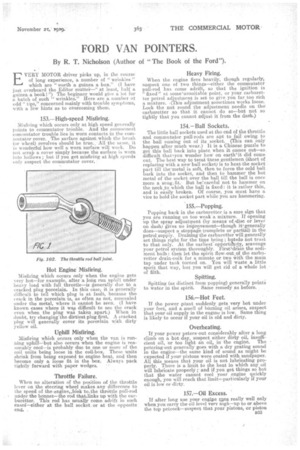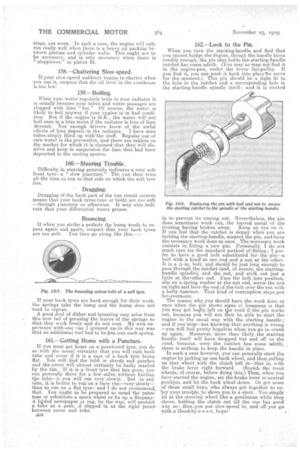FORD VAN POINTERS.
Page 37

Page 38

If you've noticed an error in this article please click here to report it so we can fix it.
By R. T. Nicholson (Author of "The Book of the Ford").
EVERY MOTOR driver picks up, in the course Of long experience, a number of "wrinkles " which are "worth a guinea a box." (I have just overheard the Editor mutter--" at least, half a guinea.a bookl ") The beginner would give a lot for a batch of such "wrinkles." Here are a number ot odd " tips," concerned mainly -with trouble symptoms, with a few hints as to oVercoming them.
I53.—High-speed Misfiring.
Misfiring which occurs only at high speed generally points to commutator trouble. And the commonest commutator trouble lies in worn contacts in the comimitatorcover. The surface against, which the brush (or wheel) revolves should be true:, All the same. it is wonderful how well a worn Surface will work. Donot scrap a cover simply because the surface is worn into hollows ; but if you get misfiring at high speeds. (ally suspect the commutator cover.
Hot Engine Misfiring.
Misfiring which occurs only when the engine gets very hot—for example, after a long run uphill under heavy load with full throttle—is generally due to a cracked plug porcelain. In this case it is generally difficult to tell which plug is at fault, because the crack in the porcelain as, as often as not, concealed
i
under the metal, where t cannot be seen. (I have .known cases where it wao difficult to see the crack even when the plug was taken ,,apart.) When in doubt, try changing:the dirtiest plug first. A cracked plug will generally coverits porcelain with dirty yellow oil.
URhill Misfiring.
Misfiring which occurs only when the van is running uphill—but also occurs when the engine is reasonably cool—is prebably due to one or more of the coil units being loose in the coil-box. These units shrink from being exposed to engine heat, and then become only a loose fit in the box. Always pick tightly forward with paper wedges. :
Throttle Failure.
When no alteration of the position of the throttle lever on the steering wheel makes any difference to the speed of the,engine„lOok to.the throttle pull-rod under the bonnet—the rod thatilinks up with the carburetter. This rod has usually come adrift in such easel—either at the ball socket or at the opposite end. .
Heavy Firing.
When the engine fires heavily, though regularly, suspect one of two things—either the commutator pull-rod has come adrift, so that the ignition is "fixed at someunsuitable point, or your carburetter petrol adjustment is set to give you far too rich a mixture. '(This adjustment sometimes works loose. Lock the nut round the adjustment needle on the. carburetter so that it cannot do so—but not so tightly that you cannot adjust it from the dash.)
154.—Ball Sockets.
The little ball sockets used at the end of the throttle and commutator pull-rods are apt to fail owing to the ball coining out of its socket. (This can only happen after much wear.) It is a Chinese puzzle to get this ball back into place when it comes out—so, difficult thaiayou wonder bow on earth'it did come out. The best way to treat. these gentlemen (Short of replacing with a new ball socket) is to beat the socket part till the'metal is soft, then to force the cold ball back into the socket, and then to hammer the hot metal of the socket over the ball till the ball is once more a snug..fita But be7careful not to hammer on the neck to which the ball is fixed : it is rather thin, and is easily broken. Of course, you must have a vice to hold the socket part while you are hammering.
155.—Popping.
Popping back in the carburetter is a sure sign that you are running on tee weak' a mixture. If opening up the spray adjustment (by means of disc or lever on dash) gives no improvement—though it,generally does—suspect a stoppage (complete or partial) in the petrol supply. Draining the carburetter will generally set things right for the time being ; butvdo not trust to that only. At the earliest-opporanSy, scavenge your petrol system thoroughly. Firstldrain the sediment bulb : then let the spirit flow out of the carburetter drain-cock for a minute or two with the main tap _under tank turned on. You will waste a little spirit that way, but you will get rid of a whole lot of filth.
Spitting.
156.—Hot Feet.
If the power plant suddenly gets -very hot under your feet, and a smell of burning oil arises, suspect that your oil supply in the engine is low. Same thing is likely to occur if your oil is old and dirty.
Overheating.
If your power peters, out considerably after a long climb on a hot day, suspect either dirty oil, insufficient oil, or too light an oil, in the engine. The petering-out generally goes with a dry grating sound in the engine---the same kind of sound as might be expected if your pistons were coated with sandpaper. All this means that your oil is not lubricating properly. There is a limit to the heat in which any oil will lubricate properly ;and if you get things so hot that the water cannot cool your mengine quickly enough, you will reach that limit-e-particularly if your oil is low or dirty.
157.—Oil Excess.
If after long use your engine runa really well only when you carry the oil level very iiign—up to or above the top petcock—suspect that your pistons, or piston B33 rings, are worn. In such a case, the engine will only run really well when there is a heavy oil packing between pistons and cylinder walls. This ought not to be necessary, and is only necessary when there is " sloppiness ' in piston fit.
158.—Chattering Slow-speed.
If your slow speed suddenly begins to chatter when Tou use it, suspect that the oil level in the crankcase is too low.
159.—Boiling.
When your water regularly boils in your radiator it is usually because your tubes and water passages are clogged with lime "fur." Of course, the water is likely to boil anyway if your engine is in bad condition. But if the engine is O.K., the water will not boll once in a blue moon if the radiator is free of lime deposit. Not enough drivers know of the awful effects of lime deposit in the radiator. I have seen tubes simply filled up with'the stuff_ Regular use of ram water is the preventive, and there are tablets on the market for which it is claimed that they will dissolve and keep in suspension the lime that had been deposited in the cooling system.
160.—Steering Trouble.
Difficulty in steering generally indicates a very soft front tyre—a "slow puncture. The van then tries all the time to run to that side on which the soft tyre lies.
Dragging.
Dragging of the back part of the van round corners means that your back tyres (one or both) are too soft —through puncture or otherwise. It may • also indicate that your differential wants grease.
Bouncing.
If when you strike a pothole the bump tends to repeat again and again, suspect that your back tyres are too soft. You then go along like this-
If your back tyres are bard enough for their work, the springs take the bump and the bump does not 'tend to repeat.
A good deal of dither and bouncing may arise from this new fad of greasing the leaves of the springs so that they work freely and do not rust. My own experience with,one van I greased up,in this way was that an additional leaf had to be put into each spring.
161.—Getting Home with a Puncture.
If you must get home on a punctured tyre, you do so with the moral certainty that you will ruin both tube and cover if it is a Cap of a back tyre being flat. You will find the tube in shreds and patches and the .cover will almost certainly be badly mauled by the rim. If it is a front tyre that has gone, you can generally drive for a few Miles without hurting tl.te tube—it you will run very. slowlY: . But in any case, it is better to runon a.bare rimvery,slowlythan to run on a flat tyre: and I do not recommend. that. You ought to be prepared to mend the puhctug°. or substitutea, spare,wheel or fix up a Stepney. A fqlded newspaper or, rag, by the' way, will liretect a tube at a gash, if slipped in at the right point*. between cover and tube.
B34
162.—Look to the Pin.
When you turn the starting-handle and find that you cannot budge the'dngine, though the handle turns readily enough, the pin that holds the starting-handle ratchet has come adrift. (You may or may not find it in the engine-pan, under the lower fan-pulley. If you find it you can push it back into place 'to serve for the moment.) This pin should be a tight fit in the hole in the ratchet and a corresponding hole in the starting-handle spindle itself: and it is, riveted
in to prevent its coming out. Nevertheless, the pin does sometimes work out, the burred metal of the riveting having broken away. Keep an eye on it.
If you feel that the ratchet is sloppy when you are turning the starting-handle, suspect the pin, and have the necessary Work done at once. The necessary work consists in;fitting anew pin. Personally, I do not much care for the standard method of fitting; I pre fer to have a good bolt substituted for the pin—a
bolt with a head' at one end and a nut at the other. It is a ?--in. bolt, and should be just long enough to
pass through the ratchet (and, of course, the starting. handle spindle); and the nut, and stick out just a little at the vother end. Pass. the bolt into position; slip on a spring washer at the nut end, screw thenut on tight and burr the end of the-bolt over the nut with a hefty, hammer.That kind of contraption stays put for,evermore.
The reason why .you should have the work done at once when the pin shows signs of looseness is that you may get baslly. left on tlie road if the pin works out,. because you will not then be able to start the engine in the usual way with the starting handle ; and if you stop—notknowing that anything is wrong —you will feel pretty hopeless when you go to crank up again. Moreover, niore than likely, the starting handle itself will have dropped but and off on the road, because, once the ratchet has come adrift, there is nothing to keep the handle in place. •
In such a case however, you can generally start the engine by jacking up one back wheel, and then pulling on that Wheel. with the clutch left in—that is, with the brake lever right forward. (Scotch the front wheels, of course, before doing this.) Then, when you
have started the engine, set the brake lever in neutral position, and let the back wheel down. Or get some of"th&Se small boys, Who always get together to en joy your trouble,'to shove you to a start. You simply sit at'the.steerink wheel like a gentleman while they shove, holding the clutch out till the van has good way on: then1-you put slow-speed in, and off you go with a Giood-by-e-e-e-e, boys!








































